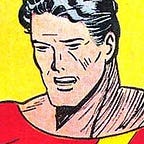Investigating the alternate history timeline of the ‘2000 AD’ strip ‘Hope’
In the 2000 AD strip Hope, writer Guy Adams and artist Jimmy Broxton (with letterer Simon Bowland) craft an atmospheric noir comic featuring Mallory Hope, a cynical private detective in 1940s Los Angeles, hired to investigate the disappearance of a child film star. The strip’s plot and characters fit comfortably within the conventions of noir fiction, but take place in a fantasy setting — an alternate history 1940s Hollywood.
For readers, investigating the strip’s historical divergence points may be as intriguing as Hope’s search for the missing child. In Hope, magic was covertly used to fight World War II, and magic users now secretly shape post-war society. The story does not dwell on how magic has caused the setting to diverge from historic events, but, like any good detective story, there are clues.
Although the story clearly takes place in post-war 1940s Hollywood, the strip is ambiguous regarding the year in which the story occurs; the strip’s summary provided by 2000 AD does not list a specific year, but rather describes the setting as “an alternate 1940s Hollywood.”
In his narration, Hope states that dark magic was used in the war, and shares his belief that the use of such magic caused President Franklin D. Roosevelt’s death from a heart attack. Roosevelt’s death is a divergence from historic events — Roosevelt died in 1945 from a cerebral hemorrhage, not a heart attack. But the strip also hints that Roosevelt died earlier than 1945.
Early in the story, the front page of the Los Angeles Times is featured; the newspaper provides evidence of several key historical divergences. The paper’s headline proclaims “PRESIDENT WALLACE’S BOLD VISION FOR POST WAR USA!” — an apparent reference to Democratic politician Henry A. Wallace.
Historically, Wallace served as vice president from 1941 to 1945. Wallace’s advocacy for progressive policies on full employment and racial equality was considered too radical by conservative elements of the Democratic Party; Roosevelt replaced Wallace on the 1944 ticket with Harry S. Truman as his vice-presidential running mate. When Roosevelt died in 1945, Truman became president.
In Hope, Wallace’s tenure as president suggests that Roosevelt died sometime between 1941 and 1944; alternatively, it could also suggest that Roosevelt kept Wallace as his running mate in 1944. If the former, events in Hope likely take place in a post-war period before 1944, with the implication that World War II was much shorter in this alternate history. Regardless, given Wallace’s historic record as a progressive champion and the paper’s headline (“BOLD VISION”), readers can surmise that President Wallace is pushing a more radical post-war progressive political agenda that diverges from historical events.
Another historic divergence identified by the paper is the new baby of film stars Clark Gable and Carole Lombard. Lombard, Gable’s wife, died in a plane crash in January 1942 while promoting the sale of war bonds. In Hope, Lombard has survived the war and continues to make headlines with her husband.
Curiously, the paper also reports “H-Bomb Test Explosion in Pacific Hinted”; the first H-bomb tests did not occur until the 1950s, and Hope makes no other reference to nuclear weapons. In this alternate history, it is unclear whether nuclear weapons were used during the war, or if fictitious atomic weapons were used as a cover story for the government’s secret war-time use of magic. The reference to an “H-bomb” (assuming the term designates a functional thermonuclear device in this altered reality) in the 1940s suggests a historical divergence in the development of nuclear weaponry.
In another panel, a sign for “Hollywoodville” can be seen; this reference to the iconic “Hollywoodland” sign — erected in 1923 to promote a housing development, later restored in 1949 by the Hollywood Chamber of Commerce without the “LAND” portion of the signage — suggests (with the subtle change of “land” to “ville”) that the story’s setting may have diverged from historic events as early as the 1920s.
The movies referenced in Hope also diverge from cinema history. Hope walks past a movie theater featuring “JOHNNY EAGER AND LANA TURNER IN EYE POPPING 3D!” If this is a reference to the movie Johnny Eager (a noir film starring Lana Turner, released in January 1942), then it suggests (assuming this film is a new release) that 1942 is the year in which the story takes place, and that WWII ended much sooner in this alternate reality. Also, the movie is in “3D”; Johnny Eager was not released in 3D (3D movies were not commercially viable until the 1950s), suggesting that 3D films are appearing a decade earlier in this alternate world.
Judging from the movies referenced in Hope, 1940s Hollywood is busy producing comedies featuring fictional child actors Buster Ritz! and Timmy Bird, and darker films starring real-world actors such as Turner, Ronald Reagan, and Ray Milland, with titles like Doom Squadron and The Lady Saw Too Much!
There is more to Hope than the background historical divergences discussed above — Mallory Hope is a tragic character, trying to find a lost child while dealing with his own magical baggage as he navigates a corrupt world. Broxton’s stark black-and-white artwork creates a gritty depiction of a noirish Hollywood that reeks of cigarettes, booze, and brimstone. But the creative team leaves subtle clues about Hope’s alternate history that no detective worthy of a trenchcoat can resist investigating.
NOTE: Hope was originally serialized in 2000 AD issues 2011–2016 and 2044–2049. The strip is collected as the trade paperback Hope …For the Future.
The images above are the property of their respective owner(s), and are presented here for nonprofit, educational purposes only under the fair use doctrine of the copyright laws of the United States of America.
